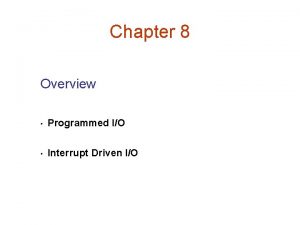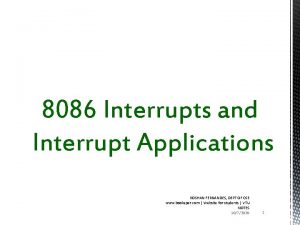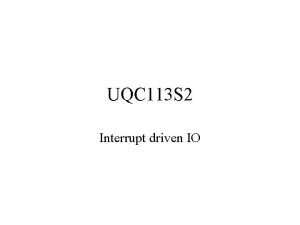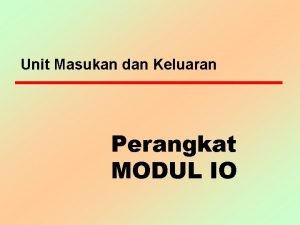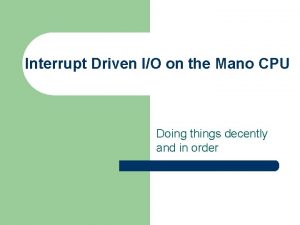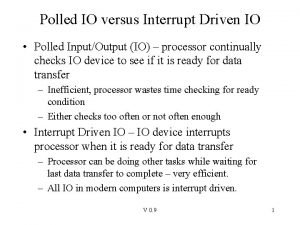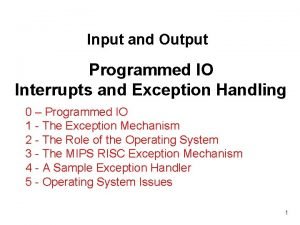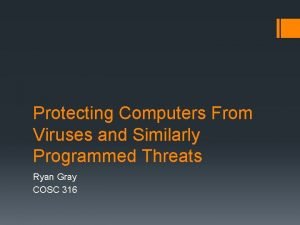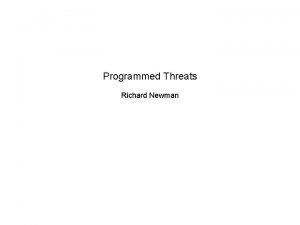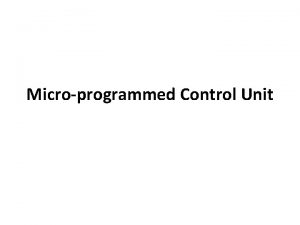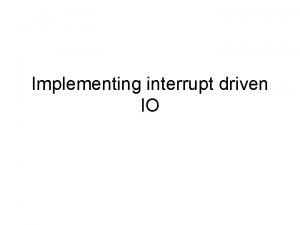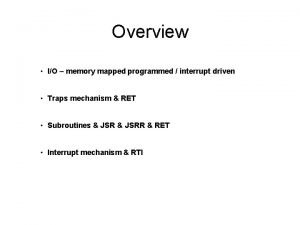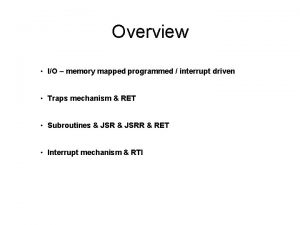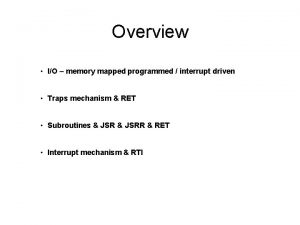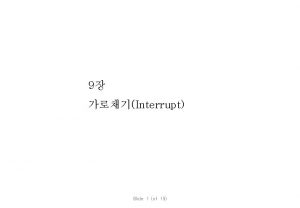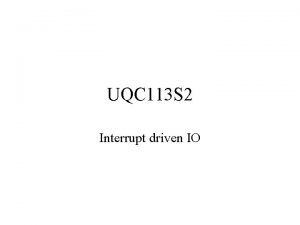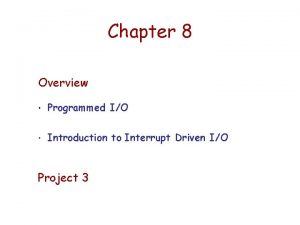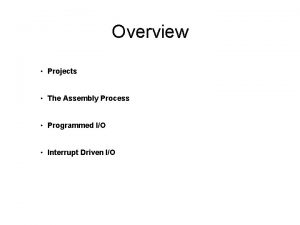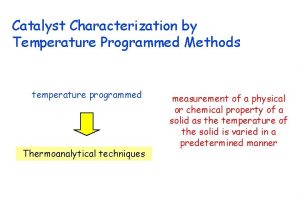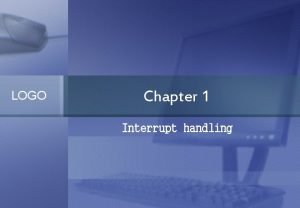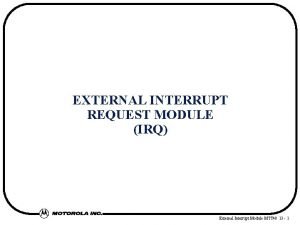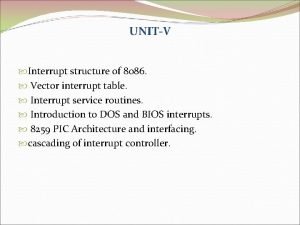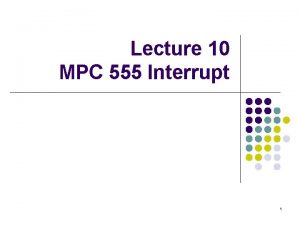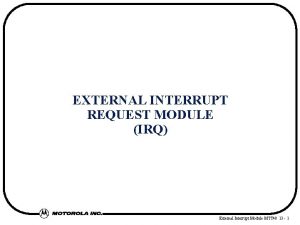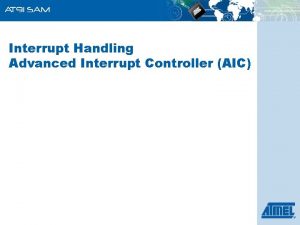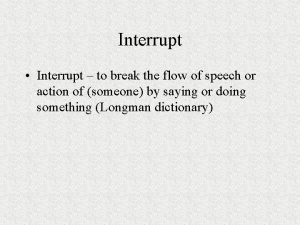Chapter 8 Overview Programmed IO Interrupt Driven IO












![Monitor Output Registers DDR: Assigned to x. FE 06 Data is in DDR[7: 0] Monitor Output Registers DDR: Assigned to x. FE 06 Data is in DDR[7: 0]](https://slidetodoc.com/presentation_image_h/87d25f700a34f16a283e86a373083582/image-13.jpg)









- Slides: 22

Chapter 8 Overview • Programmed I/O • Interrupt Driven I/O

Digressing How do you do the following in the LC-3 ? (good test question ? ) • Shift left • Rotate left • Shift right • Rotate right

One Pass vs Two Pass Assemblers • Two Pass – Checks for syntax errors and builds the Symbol Table during first pass, resolves operand addresses during second pass. • One Pass – Checks for syntax errors, builds the Symbol Table, and resolves operand addresses during the first pass. So why have a two pass?

More than One Object (Load) File • Symbol Table Symbols Start Number Data External Imports Data Value • Addresses x 3000 x 300 A x 300 D ? The “Linker/Loader” would generate another “global table to resolve Externals & Exports at Load time

Input / Output Memory Mapped I/O – A section of the memory address space is reserved for I/O Registers rather than general memory locations. Think of it as “pseudo” memory. The same instructions are used for general programming and I/O programming. Non-Memory Mapped I/O – There is a separate address space for I/O programming, and an entirely separate set of I/O Instructions.

LC-3 has Memory Mapped I/O LC-3 Memory Layout: x 0000 – x 00 FF Trap vectors x 0100 – x 2 FFF System Programs & Data x 3000 – x. FDFF User Programs Area x. FE 00 – x. FFFF I/O Programming “Registers”

Synchronous vs Asynchronous I/O Synchronous – latest value of data could be expected to be available when the program wanted it. It might be periodically updated at a know frequency. This is not typical nor usually realistic for I/O. Asynchronous – computer is generally much faster than I/O so program must wait until requested data is available or data provided has been taken. “Handshaking” is used to ensure that data is available or I/O device is ready.

Polling vs Interrrupt Driven I/O Polling – program checks handshaking signals to find when data is available of device is done (typically a loop in the program) Interrupt – program initiates I/O and waits until data is available (typically goes to sleep until the operating system wakes the program up)

Keyboard Input Interface

Keyboard Input Registers KBDR: Assigned to x. FE 02 Data is in KBSR: KBDR[7: 0] Read only Register Assigned to x. FE 00 Status is in KBSR[15] Set to “ 1” when new data is ready Cleared when data is read

Simple Program to Input from Keyboard START LDI R 1, A ; Test for BRzp START ; character input LDI R 0, B BRnzp NEXT_TASK ; Go to the next task A . FILL x. FE 00 ; Address of KBSR B . FILL x. FE 02 ; Address of KBDR

Monitor Output Interface
![Monitor Output Registers DDR Assigned to x FE 06 Data is in DDR7 0 Monitor Output Registers DDR: Assigned to x. FE 06 Data is in DDR[7: 0]](https://slidetodoc.com/presentation_image_h/87d25f700a34f16a283e86a373083582/image-13.jpg)
Monitor Output Registers DDR: Assigned to x. FE 06 Data is in DDR[7: 0] DSR: Assigned to x. FE 04 Status is in DSR[15] Set to “ 1” when data is picked up Cleared when new data is written

Simple Program to Ouput to Monitor START LDI R 1, A ; Test to see if BRzp START ; output register is ready STI R 0, B BRnzp NEXT_TASK A . FILL x. FE 04 ; Address of DSR B . FILL x. FE 06 ; Address of DDR

LC-3 Memory Mapped I/O

Echo from Keyboard to Monitor START LDI ECHO R 1, KBSR BRzp START LDI R 0, KBDR LDI R 1, DSR BRzp ECHO STI R 0, DDR ; Test for character input ; Test output register ready BRnzp NEXT_TASK KBSR . FILL x. FE 00 ; Address of KBSR KBDR . FILL x. FE 02 ; Address of KBDR DSR . FILL x. FE 04 ; Address of DSR DDR . FILL x. FE 06 ; Address of DDR

The I/O Routine for the LC-3 Keyboard START ST R 1, Save. R 1 ; Save registers needed ST R 2, Save. R 2 ; by this routine ST R 3, Save. R 3 LD R 2, Newline ; L 1 LDI R 3, DSR BRzp L 1 ; Loop until Monitor is ready STI R 2, DDR ; Move cursor to new clean line LEA R 1, Prompt ; Starting address of prompt string ; Loop L 2 LDR R 0, R 1, #0 ; Write the input prompt BRz Input ; End of prompt string LDI R 3, DSR BRzp L 2 ; Loop until Monitor is ready STI R 0, DDR ; Write next prompt character ADD R 1, #1 ; Increment Prompt pointer BRnzp Loop ; Get next prompt character LDI R 3, KBSR BRzp Input ; Poll until a character is typed LDI R 0, KBDR ; Load input character into R 0 LDI R 3, DSR BRzp L 3 ; Loop until Monitor is ready STI R 0, DDR ; Echo input character ; Input L 3 ; L 4 ; LDI R 3, DSR BRzp L 4 ; Loop until Monitor is ready STI R 2, DDR ; Move cursor to new clean line LD R 1, Save. R 1 ; Restore registers LD R 2, Save. R 2 ; to original values LD R 3, Save. R 3 BRnzp NEXT_TASK ; Do the program's next task

The I/O Routine for the LC-3 Keyboard (2) Save. R 1 . BKLW 1 Save. R 2 . BKLW 1 Save. R 3 . BKLW 1 DSR . FILL x. FE 04 DDR . FILL x. FE 06 KBSR . FILL x. FE 00 KBDR . FILL x. FE 02 Newline. FILL x 000 A Prompt ; Memory for registers saved ; ASCII code for newline . STRINGZ "Input a character>"

I/O Interrupts Requirements for a device to interrupt the processor • The device must have the right to request service • The I/O device must want service • The device request must be at a higher priority than what is being done by the processor or is being requested by other devices • The processor must be completed with the present instruction execution

Device(s) Generating Interrupt Request

Generating the LC-3 Interrupt Request

Servicing an Interrupt The following process is followed to service an interrupt • The CPU enters the Supervisor State • The “context” of the present program is saved (PC, PSW, SP) • The device provides the address of location in the interrupt service routine table where the pointer to the service routine should reside. • The Supervisor loads the address of the service routine into the PC • The service routine is executed (ending with an RTI) • The context of the original program is loaded and the original program resumed
 Programmed io vs interrupt driven io
Programmed io vs interrupt driven io 8086 interrupts and interrupt responses
8086 interrupts and interrupt responses Interrupt driven io
Interrupt driven io Jelaskan teknik arbitrasi bus
Jelaskan teknik arbitrasi bus What is interrupt driven
What is interrupt driven Polled i/o
Polled i/o Example of non programmed decision
Example of non programmed decision Example of non programmed decision
Example of non programmed decision Counters in plc
Counters in plc Nano programming in computer architecture
Nano programming in computer architecture In managing attractions, a programmed decision is
In managing attractions, a programmed decision is Give an example of programmed decision
Give an example of programmed decision Classical administrative and political decision making
Classical administrative and political decision making Decision making under bounded rationality
Decision making under bounded rationality Non programmed decision example
Non programmed decision example Bill cosby natural childbirth
Bill cosby natural childbirth Programmed instruction in hrm
Programmed instruction in hrm Programmed io
Programmed io Physical perceptual and language development
Physical perceptual and language development Infancy and childhood physical development
Infancy and childhood physical development Programmed threats
Programmed threats Programmed threats
Programmed threats Functioning of micro programmed control unit
Functioning of micro programmed control unit
